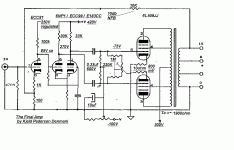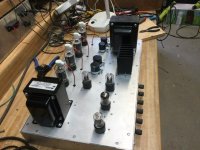Hello everyone,
I can get a great deal on 100W, 2.1KΩ P-P Transformers, will the 2.1KΩ P-P be too low for use with sweep tubes?
Thanks
Ray
I can get a great deal on 100W, 2.1KΩ P-P Transformers, will the 2.1KΩ P-P be too low for use with sweep tubes?
Thanks
Ray
I use ~2k2 in most of my sweep tube designs, and even 1k3 on some. 320V B+ or so. How much current can the primary take? With 320V and 2k2, you can get ~400mA peak currents from each tube.
If it’s “100 watts” it will be sized for the appropriate AC current, which of course can go high at low Z. DC will place limits on idle current (even if flux is balanced) since it contributes nothing to output power yet contributes to heating. High bias (or class A) triode operation may or may not be possible at full rating, while closer-to-B operation in pentode most certainly would be ok. If the trafo in question was made for guitar amps it probably wouldn’t have the primary winding sized for lots and lots of DC bias.
Actually this transformer was designed for a guitar amp. Am I wasting $112? It is manufactured by Heybour.
Heyboer is capable of winding excellent transformers, but we don’t know what specs these were designed to. $112 per pair? Go for it then, but find out the specs. Build something like kodabmx’s amps, or this one (if UL) that a diy member published a couple of years ago, title the “Final Amp”; can’t find the thread now:
Attachments
That one will have 40 Hz response, and will only be designed for 150 mA or so of DC bias (50-75mA, x 2 pair - typical for bass amp using common tubes). Might be good enough for your app. At $112 per pair instead of each it does look attractive, even if you only get 60-80 watts at 20 Hz. High end may or may not go all the way to 15 or 20k. I guess the only way to know is buy and try.
Guitar transformers have limited bandwidth , better save money for real hifi . You don't need 100W anyway
Probably those are made for parallel push-pull 2 + 2 EL34 , 6L6GT or similar tubes
Probably those are made for parallel push-pull 2 + 2 EL34 , 6L6GT or similar tubes
I guess this transformer is intended to replace the OT of a Fender Twin Reverb or similar amplifier, isn't it?
Best regards!
Best regards!
I don't see any indication on that spec sheet that the transformer is intended for bass guitar. That transformer is exactly the same size as the "80 VA from 80 Hz to 5 KHz" Shumaker guitar amp transformers that I have. I have seen over 200 watts flow through my Shumakers at 1 KHz, but when driven by an EL84 the low end gets nasty at between 10 and 20 watts depending on the feedback level. Drive the same transformers with 6HU5's (a 6DQ5 in a 12 pin bottle) in Pete's big red board and you can get 40 to 50 watts at 30 Hz due to the lower driving impedance provided by the big tubes with a bit of Schade feedback.
Want 100 watts for about the same money, get a set of the big Edcors. They will make 100 watts at 30 Hz. They are about twice the weight of the Shumakers. Size matters below 100 Hz.
Want 100 watts for about the same money, get a set of the big Edcors. They will make 100 watts at 30 Hz. They are about twice the weight of the Shumakers. Size matters below 100 Hz.
I think it's a good idea to plan a little extra space on the chassis, just in case the plate-plate impedence is too high for the output transformer. That way you can add another pair of output tubes in parallel, to lower the impedence, if need be. Just my seat of the pants method of playing with oddball tubes.
It’s looking less and less like something you’d want - didn’t realize it was THAT teeny tiny. Classic Tone did have some models that were big enough for bass guitar use. They tended to cost $150, same as the Hammond 1650T.
I admit I didn't do a deep dive, so it seems what they claim to be a 100W transformer is not a 100W transformer.
Speaking of the Hammond 1650T 120W 1900Ω. Planned a six tube 6BG6G amp. Previously had made six tube (6BG6G) amps with Altec 1569A, which worked great. It turned out that it needed eight with the Hammond 1650T. Sounded excellent.
6BG6 only has the current capability of the 6L6, because of the 900 mA heater. Not surprised you need a bunch of them. I’m driving a 1650T with four 26DQ5 (off-voltage heaters are much cheaper) and it makes 137 watts with the screen down at 125V. Two would almost do it - probably would if I pushed the screens to rating. Those impedances are about right for the big sweep tubes, and the little ones are cheap enough to parallel a bunch of anyway. Driving 1650W’s with six 6550 and a lot more B+. Four would do it - but only if I ran the screen up at 400V. Rather buy six $40 tubes instead of four over and over again - and it does give noticeably better damping factor. Ended up with iron fist bass and VERY clean clipping that sounds like a Crown Macrotech. The “little“ DQ5 bass amp sounds “tubey-er”, but most of that is the intentional current starving in the preamp section.
Attachments
Interesting looking driver section on your amp. The heat sink is for SS regulation?? I use a Maida regulator for the screens and (6SN7) driver section. I am very fond of the sound of circa 70s-80s Soviet version of 6BG6G, and have >100 of them, acquired for a reasonable price decades ago. Very clean and neutral sounding, not tubey. US versions sound tubier.
The driver section isnt that unusual - just 12SN7 LTP PI and 12SL7’s for gain stages. Bought a few dozen NOS from Stan for $5 pop before he passed. I wanted to keep the topology pretty normal, other than using sweeps for finals. One experiment at a time. The only “unusual“ feature in the front end is parametric sweepable midrange using a gyrator. I did have one spare triode so I used it there. I did want to stay all octal for that build - it’s point to point and they’re just easier. Yes, the heat sink is for voltage regs - 125 for screen (from a lower tap on the main B+ to reduce dissipation) and 325 for the front end. Just stacks of zener diodes filtered by a cap and source followers.
I would have expected it the other way round - 12SL7 as PI, 12SN7 as voltage amplifiers, due to the SL's much higher µ, from which a LTP would benefit..
Best regards!
Best regards!
- Home
- Amplifiers
- Tubes / Valves
- 2.1KΩ P-P Transformer and Sweep Tubes

